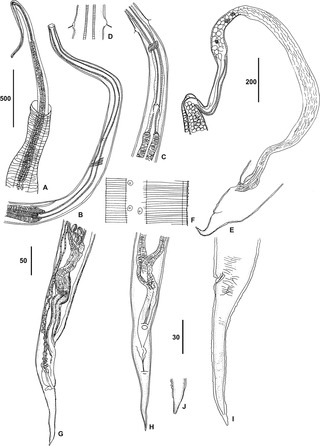Northern root-knot nematode is a species of vegetable pathogens which produces tiny galls on around 550 crop and weed species. They invade root tissue after birth. Females are able to lay up to 1,000 eggs at a time in a large egg mass. By surviving harsh winters, they can survive in cold climates.

Sodium azide is an inorganic compound with the formula NaN3. This colorless salt is the gas-forming component in some car airbag systems. It is used for the preparation of other azide compounds. It is an ionic substance, is highly soluble in water, and is very acutely poisonous.

Enoplea (enopleans) is a class, which with the classes Secernentea and Chromadorea make up the phylum Nematoda in current taxonomy. The Enoplea are considered to be a more ancestral group than the Chromadorea, and researchers have referred to its members as the "ancestrally diverged nematodes", compared to the "more recently diverged nematodes" of Chromadorea.

The Chromadorea are a class of the roundworm phylum, Nematoda. They contain a single subclass (Chromadoria) and several orders. With such a redundant arrangement, the Chromadoria are liable to be divided if the orders are found to form several clades, or abandoned if they are found to constitute a single radiation.
Modesto Francisco Fernández Díaz-Silveira is a Cuban government official that travels often around the world talking about the environment.
Pratylenchus vulnus is a species of plant pathogenic nematode best known for infecting Persian walnut. It is also known to infest potatoes, apricots, peaches and nectarines, holiday cacti, grape and citruses.
Paratylenchus projectus is a plant pathogenic nematode infecting several hosts including African violet, soybean, and sunflower.

Spirurida is an order of spirurian nematodes. Like all nematodes, they have neither a circulatory nor a respiratory system.

Nematology is the scientific discipline concerned with the study of nematodes, or roundworms. Although nematological investigation dates back to the days of Aristotle or even earlier, nematology as an independent discipline has its recognizable beginnings in the mid to late 19th century.

Diplogasterida was an order of nematodes. It was sometimes placed in a monotypic subclass Diplogasteria, but molecular phylogenetic evidence has shown it to be embedded in the family Rhabditidae. The confusion of having a hierarchical nesting of groups that were formerly mutually exclusive has led to a profusion of names. Although completely revised taxonomy of nematodes that builds on recent classification systems as well as recent phylogenetic evidence is still necessary, most contemporary taxonomic studies now treat all groups listed under "Diplogasterina" below as a single family, Diplogastridae.

The nematodes, roundworms or eelworms constitute the phylum Nematoda. They are a diverse animal phylum inhabiting a broad range of environments. Most species are free-living, feeding on microorganisms, but there are many that are parasitic. The parasitic worms (helminths) are the cause of soil-transmitted helminthiases.

Thelazioidea is a superfamily of spirurian nematodes in the large order Spirurida. Like all nematodes, they have neither a circulatory nor a respiratory system.

A nematode infection is a type of helminthiasis caused by organisms in the nematode phylum.
Spiruroidea is a superfamily of Spirurida.

Hoplolaimidae is a family of plant pathogenic nematodes. It has two subfamilies, Hoplolaiminae and Rotylenchulinae. Typically hoplolaimids are ecto- or semi endoparasites of higher plants.
Helicotylenchus is a genus of nematodes in the family Hoplolaimidae. They are known generally as spiral nematodes. They are found worldwide because they can live and survive in a wide range of habitats. They are among the most common parasitic nematodes of plants; found in corn, bananas, grass, soybeans.
Legerella is a genus of parasitic alveolates of the phylum Apicomplexa. Species in this genus that usually infect the malpighian tubules of invertebrates.
Enoplida is an order of nematodes. It is one of two orders in Enoplia, which is one of two subclasses in Class Enoplea.
Flhorban 920 (FB920) is a synthetic banana hybrid developed as a cultivar of banana naturally resistant to Black and Yellow Sigatoka fungi in an attempt to replace the highly susceptible Cavendish banana. Additionally, FB920 has been shown to improve root resistance to Burrowing nematodes.
This page is based on this
Wikipedia article Text is available under the
CC BY-SA 4.0 license; additional terms may apply.
Images, videos and audio are available under their respective licenses.









